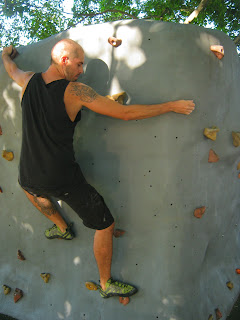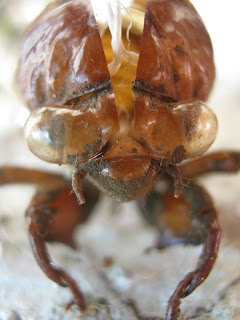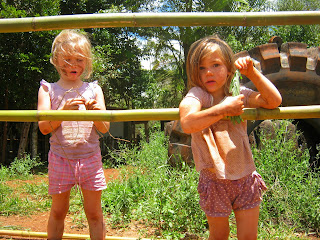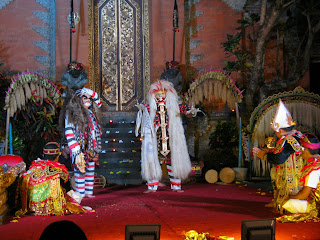Meie 8ine lend Balilt v6ttis aega neli tundi et j6uda Queenslandi, Cairnsi linna, ja me magasime terve lennu. Me lendasime esmakordselt JetStariga, Austraalia odavlennuliiniga, ning olime yllatunud kui suur nende istmetevaheline ala oli, jalgu sai ikka korralikult sirutada. Istmed ise tundusid ka suuremad, mist6ttu oligi lend nii mugav ja v6imaldas meil kohest uinumist.
Cairsi lennujaama j6udes olime me kyll immigratsioonipunkti kysitluseks valmis, ent ei osanud siiski oodata seda, mille osaliseks me saime. Passikontrolli l2bisime me yllatavalt kiiresti, ent seej2rel paluti meil pagasikontrolliks k6rvale astuda, n2itlikult suvalise valiku t6ttu. Sel ajal kui mina seisin ja j2lgisin, kuidas meie seljakotid tyhjendati ja p6hjalikult l2bi uuriti, tegi immigratsiooniametnik Paolole p6hjalikku intervjuud, kysides talt ta eelnevate passide kohta ning et kas ta on ka varem Austraaliasse proovinud siseneda. Paolo seletas, kuidas ta viimane pass talt 2008. aastal Barcelonas koos k6ige muuga 2ra r88viti, ning kinnitas, et ta polnud varem Austraaliasse tulemise peale isegi m6elnud - mille peale ametnik l6puks tunnistas, et tegu polnud siiski suvalise kontrolliga. Tuli v2lja, et Paolo oli juba enne Austraaliasse j6udmist 2ra m2rgitud, kuna millalgi v2hemalt viis aastat tagasi oli keegi yritanud tema passi kasutades Austraaliasse inimesi sisse smugeldada! Ilmselgelt oli Paolo sellest shokeeritud, esiteks kuna on 8udne m6elda, et keegi oli yritanud (ja ehk varem ka 6nnestunud) tema nime inimkaubanduseks kasutada, ning teiseks, kuna tegu oli esimese korraga millal ta sellest kuulnud on! V6iks ju arvata, et identiteedivarguse puhul v6taksid ametnikud varguse ohvriga yhendust, eriti kuna v6ib kindel olla, et ta hilisematel juhtudel seet6ttu piiridel kinni v6idaks pidada. Ja pole ju ennekuulmatu, et identiteedivarguse ohvreid ka ekslikult vangi pannakse. Seega oli meil 6nne, et smugeldamiskatse juhtus mitu aastat tagasi, et riik, kus see juhtus ei olnud kuskil kus inimesi esmalt vangi visatakse ja alles seej2rel neilt kysimusi kysitakse, ning et k6ik meie paberid ja dokumendid korras olid - kuna teistsuguses olukorras oleks meil v6inud tunduvalt halvemini minna. Ma pean kyll ytlema, et k6ik kontrollis osalenud t88tajad olid ylimalt viisakad ja rahulikud ning seletasid olukorda meile v2ga h2sti. Kuna me ise aga oleme reisimisega kaasnevate ebamugavustega harjunud, olime me koost88aldis ning kontrolliga v2ga kannatlikud (isegi kui mu kosmeetikakotikese iga ese eraldi v2lja v6eti ja uuriti :D). Seega lasti meil heade s6nadega minna ja k6ik oli l6pus ikka korras, ent sellised kogemused on ehmatavad kyll...
Igal juhul, olnud turvaliselt Austraalia maapinnale j6udnud, s6itsime me taksoga (kuna muud transpordiv6imalust ei olnud) Cairnsi kesklinna. Me olime otsustanud Cairnsi lennata kahel p6hjusel - esmalt, kuna me tahtsime Queenslandi minna ja Suurt Vallrahu n2ha (mida me pole kyll veel j6udnud teha), ent praktilisemal noodil kuna Balilt olid lennud Cairnsi tunduvalt odavamad kui yhtegi teise sihtpunkti (kummaliselt ka Darwinisse, mis on Balile palju l2hemal). Cairns, tagasihoidliku 142 000 elanikuga, on p6hja-Queenslandi teine suurim linn. Linna keskus on v2ike ja peamiselt koondunud ymber Esplanaadi, oma kauni ranniku22rse promenaadiga. Nagu paljud teised noored linnad endistes koloniaalriikides, on ka Cairnsi t2navad pikad, sirged ja ristuvad omavahel yhtlaste vahemaade j2rel 90-kraadiste nurkadega - yhes6naga on seal v6imatu 2ra eksida.
Meie hotell asus Esplanaadi p6hjapoolse osa l2hedal ning kesklinna keskus asus l6unapoolses osas, seega jalutasime me kahe Cairnsis veedetud p2eva jooksul kyllaga m88da rannikut. Jalutusk2ikude ajal yllatas meid avalike rajatiste kyllus ja kvaliteet - Esplanaadi 22res leidus mitu 2gedat laste m2nguv2ljakut, rulapark, kyllaga joogiveekaevusid, v2ike kaljuronimisekoht, mitu treeningupunkti jpm. K6ige rohkem avaldas meile muljet aga kaks asja - hiigelsuur ja ylimalt h2sti hoitud bassein Esplanaadi l6unapunktis, purskkaevude, liivaranna ja dushikabiinidega; ning kaetud grillimispunktid suurte ning lihtsalt kasutatavate gaasigrillidega. K6ige uskumatum asi basseini ja grillide juures - m6lemad on t2iesti tasuta ning kasutada saab neid iga p2ev! Paolo sai isegi grilli proovida kui me eelmise p2eva hiinakat yles soojendasime (r2mpstoit oli ainus toit mida me endale Cairnsis lubada saime, kuna hinnad olid p6rutavad).
Jalutades Esplanaadil, avastasime me veel yhe 2geda asja - tasuta kursused iga p2ev, sh nt jooga, aeroobika ja kaljuronimine. Kaljuronimise (v6i 6igemini boulderingi) kursus leidis aset meile sobival ajal ja otsustasime kohale minna. Kursus kestis tund aega, peale meie oli kohal umbes seitse algajat ronijat ning entusiastlik juhendaja kes varustas meid k6iki ronimisjalatsitega ja andis meile h2id nippe esmaseks ronimiseks. L6bu oli meil laialt ja olime ylimalt rahul, et saime t2iesti tasuta ronimist proovida.
P2rast kahte 88d Cairnsis v6tsid meid autoga peale meie esimesed HelpXi v66rustajad, et s6ita nende koju ja nendega kaks n2dalat koos elada. HelpX (ehk Help Exchange) on suurep2rane veebisait, mis viib kokku inimesi, kel on tarvis veidi abi oma kodus, aias v6i talus, ning vabatahtlikud (paljud neist turistid), kes on valmis seda abi pakkuma. 4-5 tunni t88 eest p2evas pakuvad v66rustajad vabatahtlikele majutust ja syya. Suur osa HelpX'i kogemusest on inimestevaheline suhtlus - see on hea viis inimestega tutvumiseks, ning koos elades on v6imalik teisi eriti h2sti tundma 6ppida. Meile kui reisijatele on tegu ka hea viisiga ymbruskonna avastamiseks, kohalikega tutvumiseks ning n2gemiseks, kuidas australlased elavad. Kui me potentsiaalseid v66rustajaid otsisime, valisime me peamiselt v2ikeseid 8kotalusid - kuna me tahtsime n2ha, kuidas v2ikese talu majandamine v2lja n2eb, ja kuidas loomade ja taimedega hakkama saada - lootuses, et yhel p2eval teeme me ehk sama.
Naljakal kombel oli meie esimene HelpX kogemus perega, kelle jaoks oli samuti tegemist esimese korraga HelpX v66rustaja olla. Nyydseks oleme me nende juures juba kaks toredat n2dalat veetnud. Pere koosneb pereisast Trevorist (kes r22gib vahetpidamata 2gedaid lugusid ja teeb k6vasti nalja), emast Shelleyst (kes hoiab hullumaja kontrolli all), viie-aastasest Mabelist (kes alati heameelega t88d aitab teha, ent samas ka meeleldi lolli m2ngib), kolme-aastasest Lorettast (kes on yliarmas ja ytleb alati eriti suvalisi ja naljakaid asju) ning v2ikesest Fredist, kes sai just eelmisel n2dalal yhe-aastaseks (ja kes teeb igasuguseid naljakaid beebiasju).
Nad elavad Ravenshoe nimelise koha l2hedal Tablelands'i platool, mis asub sisemaal ning meretasemest k6rgemal ning kus seega on veidi jahedam kui kuumal rannikul. Nende talu ei ole hiigelsuur, ent siin on k6ikidele rohkelt ruumi, sh nende mitmetele loomadele - yheksale ylis6bralikule koerale, hulgake kalkunitele, hobusele (Clydesdale'i sorti pakihobune Hercules) ning eesel Hectorile. Meie enda elamine siin on ylilahe - me magame 12-meetrise koolibussi sees!
Kuna pere on siin vaid kolm aastat elanud, on talus ja krundil kyllaga t88d teha ning viimaste n2dalate jooksul oleme me neid igasuguste asjadega aidaud - sh aia korrastamine, kulu p6letamine, bambuse l6ikamine ja transport, bambusest aia ehitamine, seemnete kylvamine, puude raiumine, majapidamise ja laste valvamisega aitamine jpm. Aga me oleme ka teistsugust t88d teinud, niisama l6buks. N2iteks tuli Paolo tydrukute rattaid remontides m6ttele ka Fredile ta esimene tasakaaluratas teha (ehk ilma pedaalideta ratas millega p6nnid saavad esmalt tasakaalu selgeks enne p2ris ratta proovimist). Trevor oli ideest samuti vaimustuses ning kaks p2eva hiljem, just Fredi synnip2evaks oli ratas valmis - ja tulemus oli super. Trevor ja Paolo on proovinud ka bambusest fl88te valmistada, vahelduva eduga :D
Ent ega me ka kogu aeg t88d pole ryganud - pea igal p2rastl6unal, kui v2jas on t88tamiseks liiga kuum, oleme me k6ik nende Land Roverisse hypanud ja ujuma s6itnud. Trevor ja Shelley tunnevad siinse kandi parimaid ujumiskohti ning on meid viinud uskumatult kaunitesse paikadesse. M6ned on olnud tavap2rasemad (nt ilus Eachami j2rv, mis on iidse vulkaanikraatri sees ning on populaarne ujumis- ja grillimiskoht), kuid paljud on olnud t2iesti metsikud, peidetud kohad ilma yhegi teise inimeseta (nt Vine Creeki kosed ja paar muud kohta kuhu j6udmiseks oleme pidanud veidi kaljuronimist tegema).
Yhel p2eval peatusime me ka metsloomade varjupaigas, mille omanikuks on yks Austria pension2r. Seal ravitakse vigastatuid metsloomi kuni nad tagasi loodusesse saab lasta, ning pysivalt hoitakse neid, kes ise vabaduses ellu ei j22ks. Seal n2gime me k2nguruid (kuigi me oleme neid ka vabas looduses n2inud - nad on siin t6epoolest igal pool), emusid, possumeid, dingosid, kohalikke lindusid nagu kookaburrad ja lorikeetid, ja muid Austraalia elukaid. Vabas looduses oleme me saanud n2ha hiigelsuurte puunahkhiirte parvesid (seda saime n2ha 8isel Esplanaadil Cairnsis), maastikke mis on silmapiirini kaetud suurte termiidipesadega, elu suurimaid ja v2rvilisemaid liblikaid, r22kimata paljudest kummalistest ja huvitavatest putukatest ja taimedest. Ringi vaadates on ilmselge, et Austraalia on miljoneid aastaid muust maailmast eraldi olnud, siinne loodus on lihtsalt nii teistsugune.
Kaks n2dalat on siin nagu niuhti m88da lennanud ning paari p2eva p2rast ongi meie aeg selle toreda perega l2bi. Laup2eval s6idame me p6hjapoole, et yhe teise v66rustajapere juures paar n2dalat olla. Siiani on meie HelpX kogemus olnud suurep2rane, ning ootame huviga selle j2tku juba uues kohas.
///////////////////////////////////////
So as I mentioned at the end of my last post, arriving in Australia was somewhat of a shock after nearly two months in Asia. Firstly, it's bizarre how it's very similar to Europe, but then at the same time also very different. The first day it really felt like we were in a film or something, everything seemed just so surreal. A more sobering experience is how we went from feeling rich to being positively dirt poor in just the short few hours that it took us to fly to Australia..
The flight we were on from Bali took four hours to reach Cairns in Queensland, and we slept through the whole thing, it was great! It was our first time flying JetStar, the Australian low-cost airline, and it was amazing how much more legroom you get on their flights. It also felt like the seats were bigger, so we got really comfortable very quickly and snoozed off in no time.
Arriving in Cairns airport, we were ready for being interrogated by Immigration, but were not prepared for the experience we received. We got through passport control in a breeze, which was surprising, but then we were taken aside to have all our luggage checked by what appeared as random selection. While I was standing by as our bags were meticulously emptied and thoroughly checked by a border guard, Paolo was aside being interviewed by an immigration agent, who asked him about how many previous passports he had had in the past and whether he had ever tried to enter Australia before. After Paolo told him how his last passport had been robbed from him (along with all of his other valuables) in 2008 in Barcelona, and that he had never even thought about traveling to Australia before, the agent finally revealed that the check was not random at all. Paolo's passport had come up with a red flag, since sometime five or more years ago someone using Paolo's passport had tried (and obviously failed) to smuggle people into Australia! Needless to say, Paolo was pretty shocked to learn of this - firstly, it's of course awful to think that someone had tried (and maybe previously succeeded) using his name for human trafficking. But also because this was the first time that he had heard of this! You would think that if identity theft happens, the authorities would make the real person aware of this, particularly as he or she will definitely have to suffer through additional checks due to that. And it is not unheard of of people being jailed because someone had used their identity for illegal activities. So we were lucky that the attempted smuggling had happened many years ago, that the country it happened in was not someplace where they would jail you first and ask questions later, and that we had all our documents and stuff all in place, because in another scenario we might have had much more trouble than that. I do have to say that the staff involved in the check were both very courteous and calm, and explained the situation to us very well. And since we are used to inconveniences during travel, we cooperated fully and were patient with the checks (even as my bag of toiletries was inspected one item at a time etc :D). So we were let go with kind words and all was well in the end, but these kinds of experiences are sobering to say the least.
Anyway, having safely arrived on Australian soil, we took a taxi (since there was no alternative) to Cairns city centre where our motel was. We had chosen to fly to Cairns for two reasons - firstly, because we wanted to visit Queensland, mainly to see the Great Barrier Reef (which we have yet to do). And more practically, because, from Bali, flights to Cairns were by far cheaper than to any other destination (strangely even to Darwin, which is much nearer to Bali - bizarre!). Cairns, even at its modest population of 142,000, is the second largest city in the northern part of Queensland. Its city centre is small, and mainly concentrated around the Esplanade, a beautiful promenade along the coastline. Like other young cities in most former colonial countries, the streets are long, straight, and cross each other in regular 90-degree angles - so it's pretty much impossible to get lost.
Our hotel was near the northern part of the Esplanade, and the proper centre of the city centre was at the south end, so during our two days in Cairns, we did a lot of walking along the coast. We were amazed at how good the public leisure facilities are - along the Esplanade, there were lots of awesome children's playgrounds, a skate park, tons of drinking fountains, a small rock climbing place, exercise stations etc. We were most impressed however by two things - the huge and extremely well-kept swimming pool at the south end of the Esplanade, which had fountains, a sandy bank on one side, and large shower and toilet facilities next to it. And the covered barbecue stations, which had big, easy to operate gas barbecues. The most amazing thing about the pool and the barbecues - completely free to use, open every day! Paolo even got to use one when he reheated some takeaway food that we had left over from the day before (takeaway food was the only food we were able to afford during our time in Cairns, since the prices are truly staggering).
During our walks along the Esplanade, marveling at the facilities, we also saw another awesome thing - free classes that are held daily, ranging from yoga and aerobics to rock climbing. The rock climbing (or to be exact, bouldering) class was held in the afternoon of the second day, and we decided to go. The class lasted one hour, had about seven attendees, and a great coach who provided us all with climbing shoes and gave us a good first lesson into rock climbing on boulders. We had a great time, and were stoked to be able to do something that cool for free!
After two nights in Cairns, we were picked up by our first HelpX host to go and spend two weeks living with them. HelpX (or Help Exchange) is a great initiative which brings together people who need some work done in their homes, gardens or farms, and volunteers (many of them travellers) who are keen to help. The hosts provide volunteers with accommodation and food, in return for about 4-5 hours of work per day. A big part of the HelpX experience is the social aspect - it's a great way to meet new people and you really get to know someone by living with them. For us as travellers, it is also a brilliant way to discover the country(side), meet locals and to see how people in Australia live. When looking for hosts, we looked up families who have small organic farms - since we would like to learn what it's like managing a small farm, having animals, gardening etc in the hopes of one day doing it ourselves.
Funnily enough, our first ever HelpX experience is with a family for whom it is also the first time to host with HelpX. By now we have already spent two weeks with them and it has been absolutely brilliant! The family consists of Trevor (who is constantly telling cool stories and making everyone laugh), Shelley (who does a brilliant job keeping the mayhem in check), five-year-old Mabel (who is a keen helper around the farm, but also just as keen to joke around), three-year-old Loretta (who is super sweet and constantly says the funniest, most random stuff) and wee Fred who just turned one last week (and does lots of absolutely hilarious baby stuff).
They live near Ravenshoe in the Tablelands, which are a bit inland and higher up and therefore not quite as hot as the coast. Their farm is not huge, but there is plenty of room for everyone, including all the animals - nine super friendly dogs, a bunch of turkeys, a horse (a Clydesdale named Hercules) and Hector the donkey. Our accommodation here is the coolest ever - we sleep inside of a 12-meter school bus, and it's just awesome.
Since they have only lived here for three years, there is still lots to do on the farm, and these last couple of weeks we have been busy helping them with tons of different stuff - tidying up the yard, building fires to burn up excess wood, going to cut bamboo for building, weaving bamboo fences, planting vegetable seeds, cutting down trees, helping with stuff around the house and looking after the kids etc. But we have also done other projects just for fun. For example, when Paolo was fixing the girls' bikes, he thought that it would be cool to make Fred his first bike as well - a balance bike (which has no pedals, and is great for toddlers to learn to balance before going on a real bike). Trevor was totally on board with the idea, and within two days, just in time for Fred's first birthday, the bike was finished, and it looks awesome. Trevor and Paolo have also tried to make flutes out of the bamboo we got, with mixed results :D
But it has not just been all about work - nearly every day after lunch, while it's too hot to work outside, we all hop on their Land Rover and drive for a swim. Trevor and Shelley know some of the most amazing swimming holes around here, and we have been in a number of absolutely gorgeous places. Some more traditional (e.g. the beautiful Lake Eacham, which is a lake inside of an ancient volcano crater, and a very popular spot for swimming and barbecues) and others completely wild, hidden and without anyone else nearby (like Vine Creek Falls and a few other spots where we had to do some fairly tricky rock climbing to reach the water).
One day we also stopped at a nearby wildlife sanctuary, run by a retired Austrian guy, where injured wild animals are treated and released, or kept in the sanctuary if they would not survive on their own in the wild. There we got to see kangaroos (we have seen them in the wild too though, they truly are everywhere here), emus, possums, dingoes, birds such as kookaburras and lorikeets and other Australian wildlife. In the wild, we have been impressed by swarms of huge fruit bats (who we saw during the night on the Esplanade in Cairns!), landscapes dotted with massive termite nests as far as the eye can see, the biggest and brightest butterflies either of us have ever seen, not to mention lots of strange and beautiful plants and insects. You can really tell that this part of the world has evolved separately from the rest for a long time, because of the bizarre and captivating endemic wildlife.
Two weeks have flown by here, and in a few days our time with this awesome family will come to an end. On Saturday, we drive further north to stay with another host family for a couple of weeks. So far, our HelpX experience has been amazing, and we are looking forward to continue seeing the country in this way.
 |
| Cairnsi Esplanaadil // On the Esplanade in Cairns |
 |
| Leia puunahkhiir // Find the fruit bat |
 |
| P2eval magasid niisama puu otsas // Just napping in the tree during the day |
 |
| Paolo ronimist proovimas // Paolo trying out bouldering |
 |
| Avalik bassein Esplanaadil // The public pool on the Esplanade |
 |
| Tasuta grill! // Free barbecues! |
 |
| Kaunis Eachami j2rv // Beautiful Lake Eacham |
 |
| Kardin-viigipuu // Curtain fig tree |
 |
| Tirtsu kest // Shell of a cicada |
 |
| Meie elamine! // Our nest! |
 |
| Elamine v2ljastpoolt // From the outside |
 |
| V2ikesed abilised // Little helpers |
 |
| Bambusaeda ehitamas // Building a bamboo fence |
 |
| Truu Land Rover viib otse j2rve 22rde // Trusty Land Rover will take you straight to the lake |
 |
| Paolo emuga s6brustamas // Paolo making friends with a suspicious emu |
 |
| Kohustuslik k2ngurupilt // The token kangaroo pic |
 |
| Sinna alla ronisimegi ujuma // We climbed all the way down to swim there |
 |
| Rahulolu p2rast ujumist // Happy after a swim |
 |
| Termiidipesad! // Termite nests! |
 |
| Paolo ja Fred puhkehetkel // Paolo and Fred resting in the shade |
 |
| Fredi ratast ehitamas // Building Fred's bike |
 |
| Perepilt // Family picture |
 |
| Hercules |
 |
| Ava tahab et talle pulka visataks // Ava wanting you to throw the stick |
 |
| Hector koos bambuseaiaga // Hector with the finished bamboo fence |
























